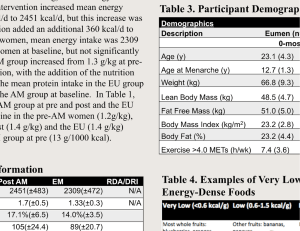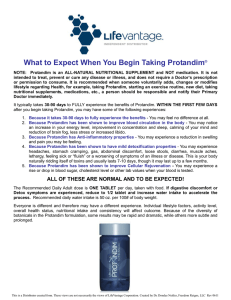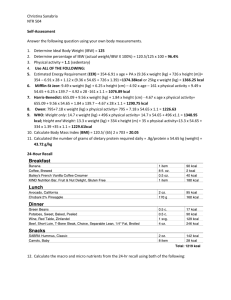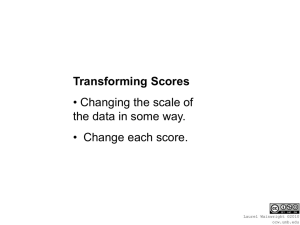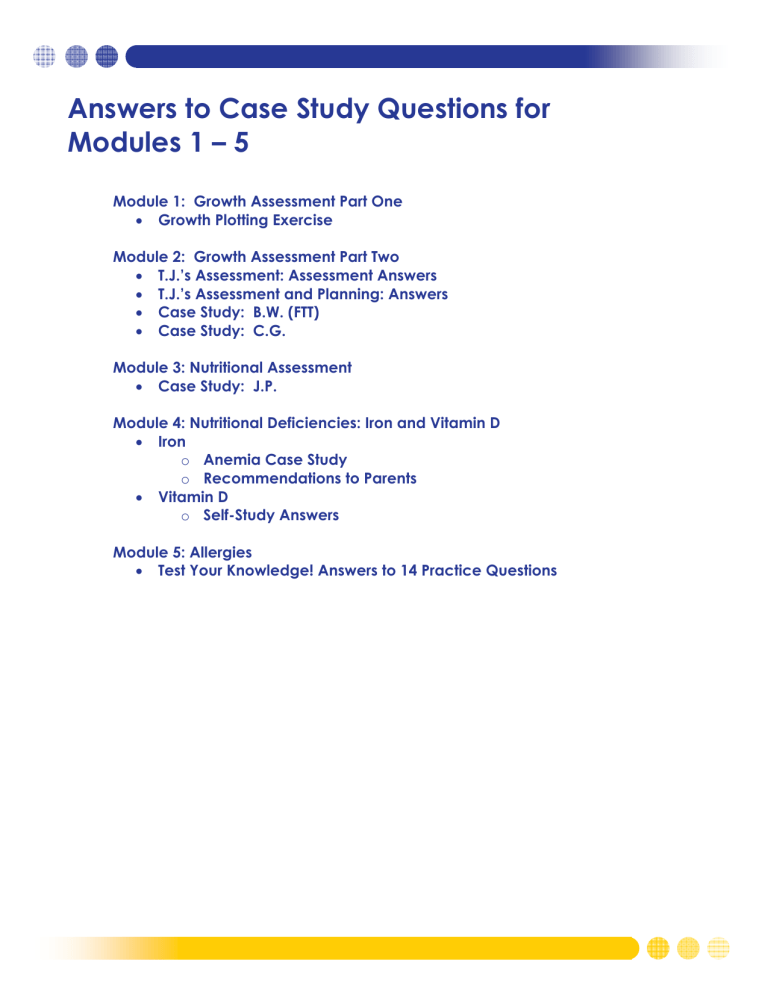
Answers to Case Study Questions for Modules 1 – 5 Module 1: Growth Assessment Part One • Growth Plotting Exercise Module 2: Growth Assessment Part Two • T.J.’s Assessment: Assessment Answers • T.J.’s Assessment and Planning: Answers • Case Study: B.W. (FTT) • Case Study: C.G. Module 3: Nutritional Assessment • Case Study: J.P. Module 4: Nutritional Deficiencies: Iron and Vitamin D • Iron o Anemia Case Study o Recommendations to Parents • Vitamin D o Self-Study Answers Module 5: Allergies • Test Your Knowledge! Answers to 14 Practice Questions Answers to Case Study Questions for Modules 1 – 5 Module 1: Growth Assessment Part One Growth Plotting Exercise Age Weight Height BMI 2 23 ¼ lbs (10.6 kg) 33 “ (82.5 cm) 15.6 3 28 ¼ lbs (13 kg) 36 ¼ “ (90.6 cm) 15.9 4 36 ½ lbs (16.5 kg) 39 ¼ “ (98.5 cm) 17 1. What growth chart should you use and what measurements need to be plotted? The most appropriate chart is the CDC Girls 2-20 years. The measurements to be plotted are weight, height and BMI for age. 2. Should you be concerned about her current growth pattern? Her weight growth pattern has been climbing over the past two years (from 10th percentile at age 2, 25th percentile at age 3, and 50-75th percentile at age 4), while her height growth has remained consistent around 25th to 50th percentile. As a result her BMI has also increased from the 25th to 50-75th to 85-90th percentile and is now in the classification of overweight. There is concern that her weight growth is exceeding her height growth and she has crossed a number of percentiles over a two year period. 3. What is your plan of care concerning growth? Discuss with the parent the accelerated weight growth over the time period and determine receptiveness to the topic at this point in time. If the parent is interested, suggest review of diet and physical activity habits and some potential goals to consider for the child and family. 2 NutriSTEP® (June 2010) Answers to Case Study Questions for Modules 1 – 5 Module 2: Growth Assessment Part Two T.J.’s Assessment Assessment Answers: Question 1: • Weight is at the 90th – 97th, height is at 50th, so yes he has jumped a couple of percentiles in the past few months. • T.J.’s BMI is 19.76, and plots ABOVE the 97th percentile. Question 2: • He would be at 17 kg (Ideal Body Weight at the 50th percentile – where his height currently plots). Question 3: • 129% IBW (given that we use his current height, and where his weight SHOULD be at the 50th percentile). • %IBW = [Current Weight (22 kg) / IBW (17 kg)] x 100% Question 4: • Mom has reason to be concerned. Check the BMI curve; with a rapid weight gain along with an IBW above 100%, TJ is at risk for weight related chronic diseases such as DM and CVD. Even now, T.J. may have elevated serum lipid levels, exercise intolerance, respiratory concerns, etc. It is important to get a better assessment rather than just weight and height to be able to determine cause and develop an appropriate nutrition care plan. T.J.’s Assessment and Planning Answers: Question 1: • Physical activity, lifestyle, social, psychological changes – all of these will help determine cause of weight gain and will be essential in helping determine your plan. Question 2: • Hypercaloric diet – energy dense but not nutrient dense. 24-hour recall demonstrated frequent consumption of high fat food items (consider types of fats – saturated versus unsaturated food items). NutriSTEP® (June 2010) 3 Answers to Case Study Questions for Modules 1 – 5 Module 2: Growth Assessment Part Two (continued) • 24-hour recall showed that T.J. is not meeting Eating Well with Canada’s Food Guide serving recommendations for vegetables and milk products. There is lack of high fibre grain products, and juice seemed to be the primary fruit serving. T.J. is at risk for certain nutritional deficiencies (i.e. Calcium, Vitamin D, Iron, Zinc) and also at risk for deficiencies such as cardiovascular disease and Type 2 DM. Question 3: • It is important to get more than one day’s recall to base your assessment on. Is this a typical day or not? Ideally use three day food intake record-see sample. The record can be provided to parent to complete prior to RD visit to assist in diet history and parent recall. • Assess stage of change both individually and the family. With a 4½ year old you can’t expect that they can make changes on their own; they need lots of support and changes in the home environment to make the plan successful. Start with 1-2 goals and proceed from there. Position it as including some fruits/vegetables rather than taking away foods. Question 4: • Follow-up on a monthly basis for a weight check and behaviour changes. • Assess if goals were attained and if so negotiate additional goals. • If possible, ask for 3 day food records to monitor overall healthy eating. Case Study: B.W. (FTT) Question 1: • You have growth data for one time period (present tense) and no additional growth data to determine growth pattern over the child’s lifespan. You have no growth data to show a change in growth velocity and how this child is plotting on the growth chart. Therefore unable to state this is FTT. Question 2: • The information you have does provide some red flags. • Nutrition concerns: At a glance, suspicions of inadequate nutritional intake for age based on Eating Well with Canada’s Food Guide, and inappropriate food choices e.g. diet products. Will require detailed food records to fully assess and identify any intake issues. Lack of parental role modeling at mealtimes and appears to be body image issues with Mom who appears to be restricting child’s intake as well food choices. • Nutritional risk level: Child is at risk for FTT due to inadequate caloric intake and potential long term eating disorder and body image concerns. 4 NutriSTEP® (June 2010) Answers to Case Study Questions for Modules 1 – 5 Module 2: Growth Assessment Part Two (continued) Question 3: • Parental advice given and resources provided. It may be necessary to involve other team members (pediatrician, social worker, and psychologist) to review parental body image and potential eating disorder and its impact on child’s intake and risk of FTT. Will need to review with parent the caloric needs of young children and parental role modeling re: food and eating together. Observe parental receptivity to determine your responsibility to involve others (social worker, CAS, etc). Provide parent with an age appropriate menu plan and ensure understanding of portion sizes, financial ability to purchase foods, etc. Question 4: • RD follow-up plans: Plan to see child in 4 weeks and request parent complete a 3 day food intake record for that visit. Plan to take weight and height at next visit to assess growth and impact of dietary advice. Case Study: C.G. Question 1: • You have been provided with growth history over the child’s lifespan. You know the child was IUGR which will cause a lower birth weight and length and can affect overall and long term growth postnatally. Therefore this child does not appear to be FTT. Question 2: • The information you have does not appear to provide any red flags. • Nutrition concerns: Growth pattern appears normal for IUGR and is monitored by GP. Diet and caloric intake appear adequate and well balanced. No parental concerns re: growth or intake. • Nutritional risk level: None. Question 3: • Parental advice given/resources provided: Keep up the good work! Question 4: • RD follow-up plans: None. NutriSTEP® (June 2010) 5 Answers to Case Study Questions for Modules 1 – 5 Module 3: Nutritional Assessment Case Study: J.P. Question 1: • Her chronological age is 42 months and corrected age is 38 months (see growth assessment part I and II for more information on this calculation). While she is technically over 3 years of age (and does not require corrected age), it might be worth noting this 4 month difference at this age since this child may never get on the growth chart due to prematurity with chronic and severe FTT in early infancy. This information will be useful in setting realistic weight and energy requirements in your assessment as well as your advice and goals to her parents. Note that if you had a complete growth history, you may find significant growth velocity over the past two years, which suggests that the parents are doing a good job. Question 2: • She remains below the 3rd percentile for weight and height (plotting at her chronological age). Her BMI is 13.2 and below the 3rd percentile, which classifies her as underweight. Her weight age is about 24 months and her height age is about 27 months (in other words, she is about the size of a two year old). Her % IBW is 83% using the “Standard Weight” or McLaren Method (weight at 50th percentile for height age). % IBW = actual weight x 100 IBW Question 3: • Her energy requirements were estimated to be 116 kcal/kg (~1160 kcal/day). • This was determined using her Ideal Body Weight (since she is <90% IBW). The equation as follows: RNI/kg with IBW: 12.3 kg x 94 kcal/kg = ~1150 kcal/day (115 kcal/kg) • Another method would be using the CUG calculation. Her estimated requirements were 116 kcal/kg; using her weight-for-age at 24 months. The equation as follows: (94 kcal/kg x 12.3 kg)/10 kg = 116 kcal/kg (~1160 kcal/day). This comes out to the same as the previous equation. In some circumstances you will have obtain different answers between the two methods, and this will create an estimated range. Question 4: • Based on your diet history, if it seems to be the child is consuming more than 1400 to 500 kcal, still suggest an additional 200 kcal/day using calorie boosters (as your caloric estimate maybe low and is actually greater than 1500 kcal/day). If it appears that JP is consuming less than 1200 kcal (e.g. 1000-1150 kcal), follow the 6 NutriSTEP® (June 2010) Answers to Case Study Questions for Modules 1 – 5 Module 3: Nutritional Assessment some care plan-200 kcal/day with calorie boosters. If it appears to be less than 1000 kcal/day, look at the meals, snacks, routines and try to incorporate additional eating times and high calorie choices. Question 5: • Follow-up with the child and parent in 4-6 weeks to assess any changes in weight and diet. You may find weight gain post follow-up depending on compliance of the family and child. However, keep in mind that the growth velocity may be slower at this age period. If there is catch-up growth, this will show success of high calorie diet. If no weight gain, but increased caloric intake reported and positive feeding situations, maintain routine and determine need to encourage more calories without adding undue parental anxiety, and child distress. Explain to parent the potential long term need for higher calorie diet due to underweight classification. Assess protein and macronutrients with DRIs and determine adequacy. NutriSTEP® (June 2010) 7 Answers to Case Study Questions for Modules 1 – 5 Module 4: Nutritional Deficiencies: Iron and Vitamin D Iron Anemia Case Study: A.B. Question 1: • Every red blood cell in the body contains iron in its hemoglobin. Anemia results in less oxygen reaching the cells and tissues, affecting their function. • Long-term consequences include behavioural and cognitive defects. If longstanding, the latter may not be reversible, even with iron supplementation. Question 2: • Centre for Disease Control (CDC) girls, 0-36months of age. This will likely change to the WHO Growth Standards for birth-age 5 for girls. Question 3: • She is following a normal growth pattern as her own growth reference. She is on 10th percentile for height and 25th percentile for weight. • She is eating adequate energy and protein to maintain good growth. Question 4: • Low birth weight and prematurity; early discontinuation of breastfeeding; and, early consumption of cow’s milk. There may also be socioeconomic factors – inadequate funds for appropriate foods. Appears to be overconsumption of caloric beverages (juice and other sweetened beverages, but also of cow’s milk), at the expense of consumption of other foods. Question 5: • Folate and B12 deficiency can also cause anemia. However, A.B.’s anemia is microcytic, indicated by a low Mean Cell Volume (MCV). Folate and B12 deficiency would cause a macrocytic anemia, where you would see an elevated MCV. In addition, ferritin levels provide insight into the iron status. 8 NutriSTEP® (June 2010) Answers to Case Study Questions for Modules 1 – 5 Module 4: Nutritional Deficiencies: Iron and Vitamin D (continued) Question 6: • Exclusive breastfeeding during 6 months of life. • Complementary foods should contain iron – for example, formula, infant cereals – may continue these beyond 1 year. • Delay cow’s milk until at least 9 to 12 months. Recommend whole milk until 24 months for fat content required for brain and eye development. Afterwards, can enjoy milk choice (2%, 1%, skim) same as the rest of the family. Recommendations to Parents: • Preschool children should have no more than 3 cups of cow's milk; milk can inhibit absorption of iron, and drinking too much milk can dampen a child's appetite for other iron-rich foods. • Limit intake of juice (max 4 oz. daily), encourage water for thirst. • Offer a variety of iron-rich foods (meats, poultry, fish, egg yolks, legumes, whole grains) • Iron supplements if necessary for increased dietary intake in the short term. May require additional teaching re: constipating effects of iron and dietary management e.g. increase fibre and fluid intake. Vitamin D Self Study Answers: Question 1 – a Question 2 – a Question 3 – a Question 4 – a NutriSTEP® (June 2010) 9 Answers to Case Study Questions for Modules 1 – 5 Module 5: Allergies and Food Intolerances Test your knowledge! Answers to 14 Practice Questions Question 1 – c Question 2 – b Question 3 – c Question 4 – a Question 5 – d Question 6 – c Question 7 – d Question 8 – d Question 9 – a Question 10 – b Question 11 – d Question 12 – c Question 13 – d Question 14 – c 10 NutriSTEP® (June 2010)
